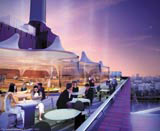Sparks fly in battersea
Parkview International is charging up Battersea Power Station for a new lease of life, with the aid of a consortium of top creative talent, says Anne Konopelski

Meanwhile, Parkview International has announced plans to convert one of the power station’s chimneys into an ultra-exclusive, eccentric restaurant. Up to 16 diners will enter the space from the chimney’s shoulder. Once they are seated at the restaurant’s single table, a hydraulic system will lift them to the top of the chimney.
Rumgay concedes that the opportunities for designers are minimal at present, but he does suggest that they will eventually appear on the horizon. ‘We haven’t got to the interiors side [of the project] yet, but we are in discussion with retailers and a cinema operator. I think there will be a number of opportunities,’ he says.
Battersea Power Station Architecture and Design Team
Sir Philip Dowson Design director
Reid Architecture Executive architect
Ron Arad Associates
Upperworld Hotel (planning permission pending)
Arup Associates
Site masterplan, with Cecil Balmond; urban resort hotel and conference hotel, with Reardon Smith Architects; auditorium; pedestrian bridge; jetty
Cecil Balmond at Arup Advanced Geometry Unit
‘Product showcase’, or exhibition space; offices, with Reid Architecture
Grimshaw
Power station, Battersea Park Station
Scéno Plus
Auditorium interior, power station central space
Gustafson Porter
Landscape
Benson and Forsyth
Residential design
Battersea Power Station History
1930 Sir Giles Gilbert Scott, also responsible for Waterloo Bridge, Liverpool Cathedral and the red telephone box, is appointed to design the power station
1933 Battersea A, comprising one turbine hall and two chimneys, is completed
1953 Battersea B, encompassing a second turbine hall and two additional chimneys, is completed
1980 The power station is granted Grade II-listed status
1982 Operations are ceased
1984 The Central Electricity Generating Board holds a seven-way competition to determine the power station’s future. It is won by the Alton Towers consortium
1986 Planning approval is granted to the consortium for an indoor theme park
1989 Funding runs out and construction is halted
1993 Parkview International purchases the consortium’s outstanding debts
1996 The group wins the freehold of the site
1997 Wandsworth Council grants outline consent for Parkview International’s plans to turn the power station site into a retail, leisure and housing complex
2001 Detailed planning consent is granted
2002 Site ‘enabling’ works begin
2004 Parkview International submits revised plans under its original consent, and advanced on-site works begin
2008 Phase one of the development, including the power station, urban resort hotel and some residential areas, is due to be completed
2009 Remainder of the site is scheduled to be completed
-
Post a comment




